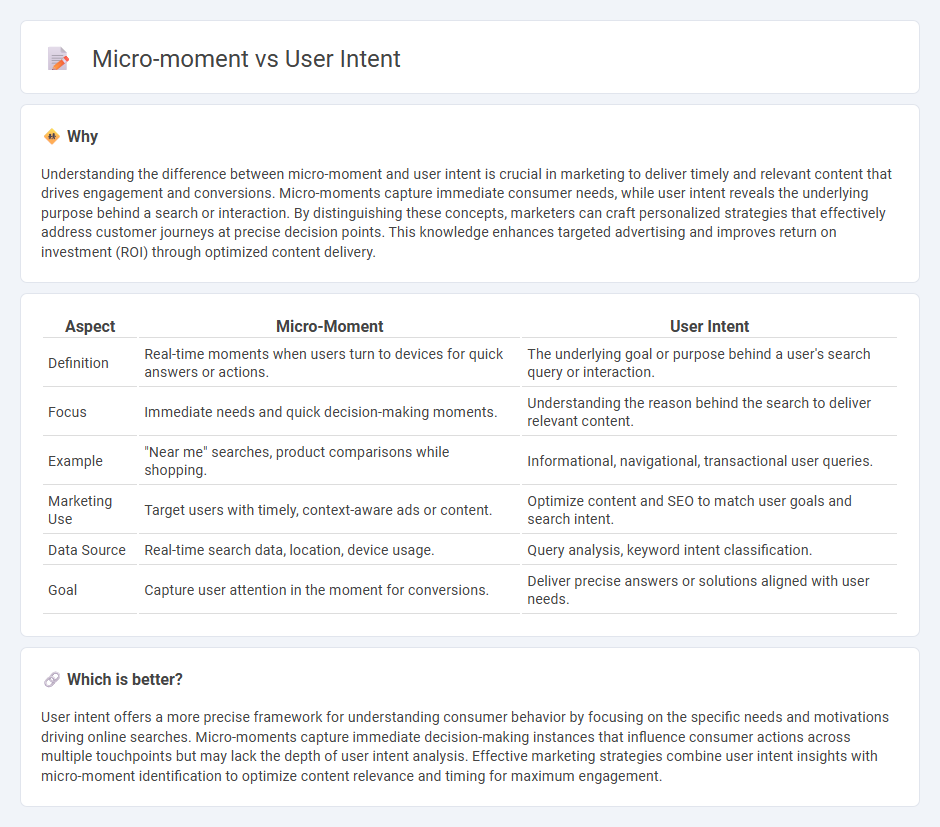
Micro-moments capture specific instances when users turn to their devices for quick information, reflecting precise user intent in real time. Understanding these intent-driven moments enables marketers to deliver targeted content that matches immediate needs, boosting engagement and conversion rates. Explore how aligning marketing strategies with micro-moments can transform user experience and business outcomes.
Why it is important
Understanding the difference between micro-moment and user intent is crucial in marketing to deliver timely and relevant content that drives engagement and conversions. Micro-moments capture immediate consumer needs, while user intent reveals the underlying purpose behind a search or interaction. By distinguishing these concepts, marketers can craft personalized strategies that effectively address customer journeys at precise decision points. This knowledge enhances targeted advertising and improves return on investment (ROI) through optimized content delivery.
Comparison Table
| Aspect | Micro-Moment | User Intent |
|---|---|---|
| Definition | Real-time moments when users turn to devices for quick answers or actions. | The underlying goal or purpose behind a user's search query or interaction. |
| Focus | Immediate needs and quick decision-making moments. | Understanding the reason behind the search to deliver relevant content. |
| Example | "Near me" searches, product comparisons while shopping. | Informational, navigational, transactional user queries. |
| Marketing Use | Target users with timely, context-aware ads or content. | Optimize content and SEO to match user goals and search intent. |
| Data Source | Real-time search data, location, device usage. | Query analysis, keyword intent classification. |
| Goal | Capture user attention in the moment for conversions. | Deliver precise answers or solutions aligned with user needs. |
Which is better?
User intent offers a more precise framework for understanding consumer behavior by focusing on the specific needs and motivations driving online searches. Micro-moments capture immediate decision-making instances that influence consumer actions across multiple touchpoints but may lack the depth of user intent analysis. Effective marketing strategies combine user intent insights with micro-moment identification to optimize content relevance and timing for maximum engagement.
Connection
Micro-moments represent critical instances when users turn to their devices with specific intents, such as "I want to know," "I want to go," or "I want to buy," making user intent the driving force behind these behaviors. Understanding and leveraging user intent within micro-moments enable marketers to deliver timely, relevant content that directly addresses immediate needs, boosting engagement and conversion rates. Effective marketing strategies focus on capturing these micro-moments by analyzing intent signals and optimizing content to match the precise expectations of consumers in real-time.
Key Terms
Search Intent
Search intent refers to the underlying motivation behind a user's query, which can be informational, navigational, transactional, or commercial investigation. Micro-moments represent critical instances when users turn to their devices to act on a need, such as "I want to know," "I want to go," "I want to do," or "I want to buy." Understanding the alignment between precise search intent and micro-moments enhances content strategy and targeting effectiveness; explore more to optimize your digital marketing approach.
Context
User intent reflects the underlying motivation behind a search query, encompassing the goals or needs a user aims to fulfill. Micro-moments are critical, context-driven instances when users turn to their devices to act on that intent, often characterized by immediacy and relevance to their current situation. Explore how understanding and leveraging micro-moments enhances targeting user intent effectively.
Real-time Engagement
User intent reflects the underlying goal driving a search query, while micro-moments capture the real-time contexts when users seek immediate answers or actions on mobile devices. Understanding the intersection of user intent and micro-moments enables brands to deliver highly relevant, context-aware content that maximizes engagement and conversion opportunities. Explore how leveraging real-time engagement strategies can transform your marketing effectiveness.
Source and External Links
What is User Intent? - MarketMuse Blog - User intent is the underlying motivation behind a person's online search, shaping content relevance and user experience through categories like navigational, informational, and commercial intent.
What is User intent? Definition - Omniconvert - User intent refers to the goal or purpose a user has when entering a query into a search engine, guiding content creation for better engagement and conversions.
User intent - Wikipedia - User intent, also known as query or search intent, is the classification of a user's goal when performing an online search, crucial for effective SEO and conversion optimization.
 dowidth.com
dowidth.com